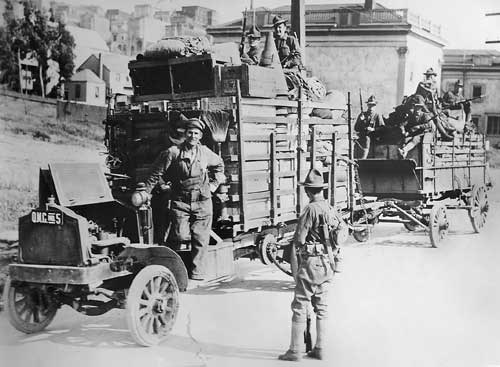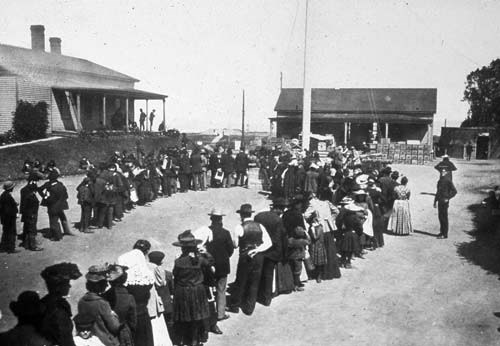|
The U.S. Army's relief efforts during the 1906 earthquake and fire not only answered the needs of the immediate tragedy but also left a legacy for future domestic emergencies. Based on the army's experience in the 1906 disaster, clear and formal policies were developed regarding civil relief and the Army's relationship with the Red Cross was formally defined.

National Park Service, Golden Gate NRA When news of the earthquake reached the War Department in Washington, army headquarters across the nation were asked to contribute to the relief effort. Soon, trains loaded with military supplies arrived in San Francisco. Quartermaster Major Carroll A. Devol noted the massive distribution of supplies at the Presidio was "without any authority, but when reported was promptly approved by the Secretary of War." Devol was placed in charge of transportation, receipt and distribution of both military and civil supplies. According to army reports, over 30,000 refugees were solely dependent on the army for food and shelter - 16,000 at the Presidio alone. Food donations began arriving in San Francisco almost immediately. However, prohibitions against fires forbade people from cooking. By April 23rd, less than one week after the earthquake, the Citizen's Relief Committee was overcome by the food distribution efforts and the mayor asked the army to take over. General Greely, now back in San Francisco, initially refused Mayor Schmitz's request to manage food distribution. It was only after prodding by members of the Committee of Fifty that Greely agreed to set up nine food depots. Each civilian was fed the equivalent of three-quarters of an Army enlisted man's rations. On April 30th more than 300,000 people were fed at these commissary food stations. The Army commissary later assisted in organizing and opening relief restaurants. Though services provided by the Army in the aftermath of the earthquake were crucial, General Greely was sensitive to the fact that the military was responsible for Federal property only. On April 29, General Orders No. 18 outlined the role of the Army in the relief efforts and appointed Army officers to work with the mayor's committee and the Red Cross. General Funston’s wife, Eda, worked with Dr. Edward T. Devine—head of the fledgling Red Cross—in establishing a relief distribution system. It was eventually agreed the Army would pass out civilian-donated clothing to the refugees. In addition, the Army established twenty-one official refugee camps. Organized and maintained in military fashion, these camps were among the safest and cleanest shelters available for earthquake refugees. 
National Park Service, Golden Gate NRA Follow the links below to learn more about the Army's relief efforts following the 1906 earthquake. Resources "Army Headquarters and the San Francisco Earthquake and Fire," Presidio file. Bronson, William. The Earth Shook, the Sky Burned, (San Francisco: Chronicle Books) 1997. Halsey, Jr., Col. Milton B. Point Paper U.S. Army Activities in the 1906 Earthquake and Fire, Presidio Ranger files. Hansen, Gladys and Emmet Condon, Denial of Disaster, (San Franciscio: Cameron and Company) 1989. "Presidio Refugee Camp is a Model of Its Kind; Thousands of the City's Homeless Well Cared for by the Military; Made to Observe the Army Sanitary Laws," San Francisco Call, 7 May 1906, 2. Russell Sage Foundation, San Francisco Relief Survey: The Organization and Methods of Relief Used After the Earthquake and Fire of April 18, 1906, (New York: Survey Associates, Inc., 1913). Strobridge,William. "Soldiers in the Streets, 1906," The Pacific Historian, Spring 1978 (vol. 22, no. 1). "Supply Situation In Hand Despite Destruction of Depot; Provisions on Way From East," Presidial Weekly Clarion, (Presidio of San Francisco), 27 April 1906. "The commissary and the San Francisco Earthquake and Fire," Presidio file. Thompson, Erwin N. Defender of the Gate: The Presidio of San Francisco, A History from 1846 to 1995, (Golden Gate National Recreation Area, California, National Park Service, 1995). |
Last updated: February 28, 2015
